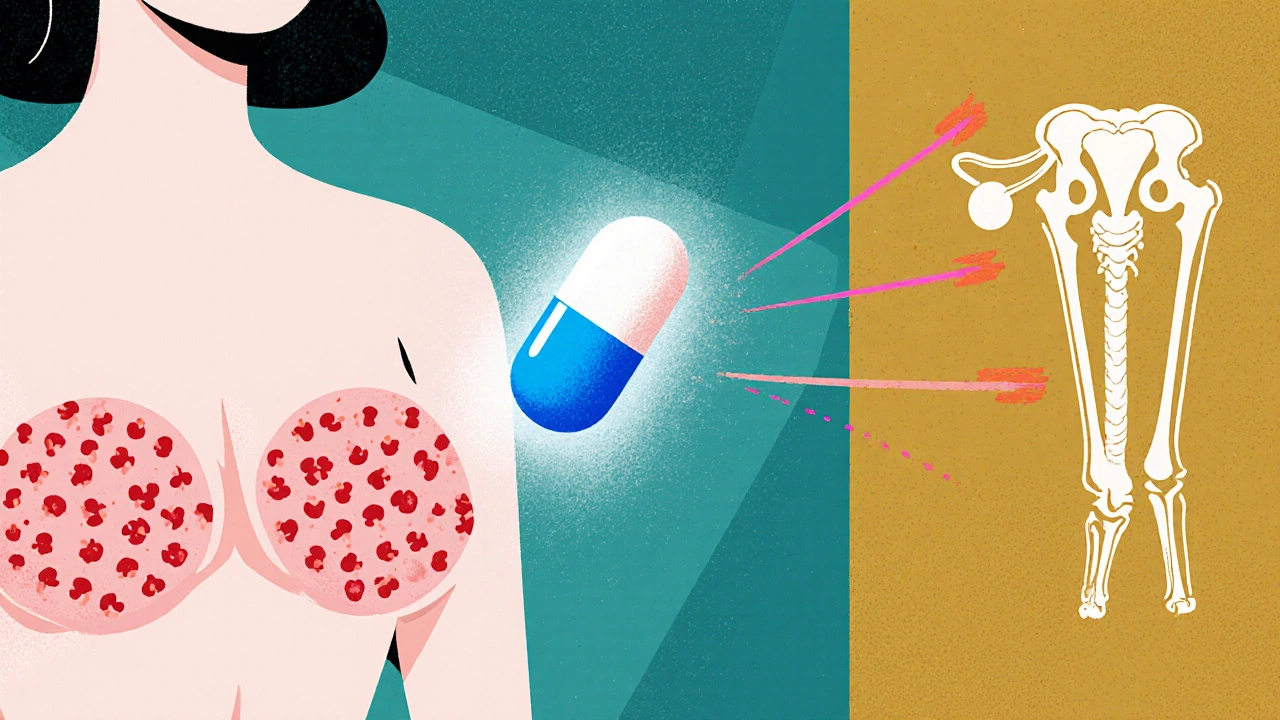Breast Cancer Drug Selector
How This Tool Works
This tool helps you understand which endocrine therapy might be most appropriate for your situation based on key factors discussed in the article. Please note: This is not medical advice. Always consult with your oncologist for personalized treatment decisions.
How do you feel about these side effects?
Recommended Options
Quick Takeaways
- Nolvadex (tamoxifen) is the go‑to SERM for early‑stage ER‑positive breast cancer.
- Raloxifene and clomiphene are also SERMs but are used mainly for bone health or fertility.
- Aromatase inhibitors (anastrozole, letrozole, exemestane) shut down estrogen production and are preferred for post‑menopausal patients.
- Fulvestrant is a pure estrogen‑receptor degrader used after other endocrine therapies fail.
- Choosing the right drug depends on menopause status, side‑effect tolerance, cost, and future treatment plans.
When treating estrogen‑receptor‑positive breast cancer, Nolvadex (generic name tamoxifen) is a widely prescribed selective estrogen receptor modulator (SERM). It blocks estrogen from binding to tumor cells while acting like estrogen in bone and the uterus. Because of this dual behavior, clinicians have a toolbox of other endocrine agents to suit individual needs. This guide walks through how tamoxifen stacks up against the most common alternatives, pinpoints where each shines, and helps you decide which option fits your situation.
What Is Nolvadex (Tamoxifen)?
Tamoxifen was first approved in 1977 for metastatic breast cancer. Over the decades it proved effective for early‑stage disease, reducing recurrence by about 40% in large trials. Chemically, it is a non‑steroidal triphenylethylene that competitively binds to estrogen receptors (ER) in breast tissue, preventing the hormone from stimulating cancer growth.
How Tamoxifen Works - Mechanism of Action
As a SERM, tamoxifen exhibits tissue‑selective activity:
- Antagonist in breast tissue: blocks ER, halting cell proliferation.
- Agonist in bone: promotes calcium retention, helping preserve bone density.
- Partial agonist in uterus: can stimulate endometrial growth, raising a small risk of hyperplasia.
The drug is metabolized by the liver enzyme CYP2D6 into active metabolites (4‑hydroxytamoxifen, endoxifen) that are 30-100 times more potent at the receptor. Genetic variations in CYP2D6 can affect efficacy-patients who are poor metabolizers may see less benefit.
Key Benefits and Risks of Tamoxifen
Benefits include a proven track record, oral dosing, and a relatively low cost (≈ $30‑$45 per month in the U.S.). It works for both pre‑ and post‑menopausal women, making it versatile.
Common side effects are hot flashes, mood swings, and mild nausea. More serious but less frequent risks are:
- Deep‑vein thrombosis (DVT) or pulmonary embolism.
- Endometrial cancer (≈ 1‑2 cases per 1,000 women per year).
- Vision changes due to retinal deposits (rare).
Monitoring includes a baseline pelvic exam, annual mammograms, and vigilance for leg swelling or unusual bleeding.

Overview of the Main Alternatives
While tamoxifen remains first‑line for many, alternative endocrine agents can be better suited based on age, menopausal status, and side‑effect profile.
Raloxifene (brand name Evista) is another SERM. It is FDA‑approved for osteoporosis and breast‑cancer risk reduction in post‑menopausal women but not for active disease.
Clomiphene is a fertility drug that also blocks estrogen receptors in the hypothalamus, increasing gonadotropin release. It isn’t used for cancer treatment but appears in discussions about SERMs.
Fulvestrant (Faslodex) is a pure estrogen‑receptor antagonist and degrader. It is given as an intramuscular injection every 2 weeks (initially) and then monthly, typically after progression on tamoxifen or an aromatase inhibitor.
The aromatase‑inhibitor family-Anastrozole (Arimidex), Letrozole (Femara), and Exemestane (Aromasin)-block the enzyme aromatase, which converts androgens to estrogen. They are the default for post‑menopausal patients because they lower circulating estrogen by > 90%.
Side‑Effect Profiles at a Glance
Understanding tolerability is key. Below is a short rundown:
- Tamoxifen: hot flashes, vaginal dryness, DVT risk, endometrial changes.
- Raloxifene: similar hot flashes, lower DVT risk than tamoxifen, no endometrial stimulation.
- Fulvestrant: injection‑site pain, joint stiffness, rare liver enzyme elevations.
- Aromatase inhibitors: arthralgia, osteoporosis risk, loss of libido, low cholesterol.
Detailed Comparison Table
| Drug | Class | Primary Indication | Mechanism | Typical Dose | Common Side Effects | Approx. Monthly Cost (USD) |
|---|---|---|---|---|---|---|
| Tamoxifen | SERM | ER‑positive breast cancer (adjuvant) | ER blockade in breast, agonist in bone | 20 mg PO daily | Hot flashes, DVT, endometrial changes | $30‑45 |
| Raloxifene | SERM | Osteoporosis, breast‑cancer risk reduction | ER blockade in breast, agonist in bone | 60 mg PO daily | Hot flashes, DVT (lower risk), leg cramps | $40‑55 |
| Fulvestrant | ER degrader | Advanced ER‑positive breast cancer after endocrine failure | Destroys ER, no agonist activity | 500 mg IM injection q2 weeks → q4 weeks | Injection pain, joint stiffness, liver enzyme rise | $1,200‑1,500 |
| Anastrozole | Aromatase inhibitor | Post‑menopausal breast cancer (adjuvant) | Blocks aromatase → ↓ estrogen synthesis | 1 mg PO daily | Arthralgia, osteoporosis, hot flashes | $90‑120 |
| Letrozole | Aromatase inhibitor | Post‑menopausal breast cancer (adjuvant) | Inhibits aromatase > 98% | 2.5 mg PO daily | Joint pain, fatigue, bone loss | $140‑170 |
| Exemestane | Aromatase inhibitor (steroidal) | Post‑menopausal breast cancer (after tamoxifen) | Irreversibly inactivates aromatase | 25 mg PO daily | Hot flashes, musculoskeletal pain, mild liver impact | $110‑130 |

When to Choose Tamoxifen vs an Alternative
Think of the decision as a flowchart:
- Menopausal status: If you’re pre‑menopausal, tamoxifen or raloxifene are the only oral options. Aromatase inhibitors require post‑menopausal estrogen levels.
- Risk tolerance for thromboembolism: All SERMs raise DVT risk, but raloxifene’s risk is a bit lower. If you have a clot history, an aromatase inhibitor may be safer.
- Endometrial health: Women with a prior endometrial hyperplasia should avoid tamoxifen and consider aromatase inhibitors or fulvestrant.
- Bone density concerns: Tamoxifen and raloxifene act as estrogen agonists in bone, protecting density. Aromatase inhibitors can worsen osteoporosis-add a bisphosphonate if you go that route.
- Cost & insurance coverage: Tamoxifen is cheap and usually covered. Aromatase inhibitors are pricier but many insurers list them as first‑line for post‑menopausal disease.
- Previous endocrine therapy: If the cancer progressed on tamoxifen, switch to a non‑SERM (letrozole or fulvestrant).
In practice, oncologists often start with tamoxifen for 5‑10 years, then transition to an aromatase inhibitor if the patient becomes post‑menopausal or if side‑effects become intolerable.
Practical Tips for Patients on Endocrine Therapy
- Adherence matters: Missing more than 20% of doses reduces disease‑free survival by 10-15% in studies.
- Track side effects: Use a simple diary (date, symptom, severity) and bring it to each oncology visit.
- Bone health: Get a baseline DEXA scan. If you’re on an aromatase inhibitor, schedule repeat scans every 1-2 years.
- Drug interactions: CYP2D6 inhibitors (e.g., fluoxetine, paroxetine) lower tamoxifen’s active metabolite-ask your doctor to choose alternative antidepressants.
- Lifestyle: Regular weight‑bearing exercise and a calcium‑rich diet help mitigate bone loss across all agents.
Frequently Asked Questions
Can I switch from tamoxifen to an aromatase inhibitor mid‑treatment?
Yes. If you become post‑menopausal or develop intolerable side effects, oncologists commonly transition to an aromatase inhibitor. The switch usually involves a short wash‑out period (about 2 weeks) to avoid overlapping estrogen suppression.
Is tamoxifen safe for long‑term use (10+ years)?
Long‑term data show continued reduction in breast‑cancer recurrence, especially for high‑risk patients. The main concerns are cumulative DVT risk and a modest rise in endometrial cancer, so regular gynecologic check‑ups are advised.
Why would a doctor prescribe raloxifene instead of tamoxifen?
Raloxifene is often chosen for women who need bone‑strengthening benefits and have a higher baseline risk for endometrial cancer. It’s approved for risk reduction, not for treating active disease, so its use is limited to prevention scenarios.
Does taking a CYP2D6 inhibitor affect tamoxifen’s effectiveness?
Yes. CYP2D6 converts tamoxifen into its most active metabolites. Strong inhibitors like fluoxetine can cut metabolite levels by up to 60%, potentially lowering the drug’s protective effect. Your doctor may switch you to an aromatase inhibitor or choose a different antidepressant.
What are the main reasons fulvestrant is used after other endocrine therapies?
Fulvestrant fully degrades the estrogen receptor, offering a different mechanism when cancers become resistant to SERMs or aromatase inhibitors. It’s given by injection, which bypasses oral absorption issues and is useful when patients have gastrointestinal side effects.
Choosing the right endocrine therapy is rarely a one‑size‑fits‑all decision. By weighing menopausal status, side‑effect tolerability, cost, and future treatment plans, you can work with your oncologist to select the drug that gives the best balance of efficacy and quality of life.


Rachael Turner
October 22, 2025 AT 16:33Reading through the comparison makes me pause and think about how each drug touches a different part of a woman's life. The hormonal dance is more than a biochemical pathway it’s a personal journey. I feel for anyone wrestling with the hot‑flash storms and the shadow of clot risk. At the same time the bone‑protecting side of tamoxifen can feel like a quiet guardian. It’s a balance of trade‑offs that deserves empathy and patience.
Suryadevan Vasu
October 22, 2025 AT 18:20Tamoxifen remains a solid first‑line option for pre‑menopausal patients.
Vin Alls
October 22, 2025 AT 20:20Alright, let’s unpack the whole endocrine toolbox with a splash of color. First off, tamoxifen is the classic workhorse – a non‑steroidal triphenylethylene that has been pounding the pavement since the late ’70s and still holds its ground in early‑stage ER‑positive disease. Its dual nature is a bit like a charismatic actor playing both hero and anti‑hero: it blocks estrogen in the breast while moonlighting as an estrogen agonist in bone, keeping the skeleton sturdy. The flip side is its flirtation with the uterus, which can occasionally stir up hyperplasia, so regular gynecologic surveillance is a must. Cost‑wise, it’s the bargain‑bin hero, usually under $50 a month, and you can pop a pill at breakfast without any fancy infusion setup. Side‑effects are a mixed bag – think hot flashes, mood swings, and a modest clotting risk, plus that rare but serious endometrial cancer signal. If you’re a pre‑menopausal woman, you’re essentially limited to SERMs like tamoxifen or raloxifene because aromatase inhibitors need that post‑menopausal low‑estrogen environment to work. Raloxifene, while also a SERM, leans more toward bone health and carries a slightly lower clot risk, but it doesn’t have the same robust data in treating active disease – it’s more of a prevention tool. Moving on to aromatase inhibitors – anastrozole, letrozole, and exemestane – these are the heavy‑hitters for post‑menopausal patients, slashing estrogen production by over 90 %. They are superb at preventing recurrence, but they can gnaw away at bone density, making osteoporosis a real concern unless you pair them with bisphosphonates or denosumab. Their price tag is higher, often three to five times tamoxifen, and they can bring joint pain, hot flashes, and a bit of fatigue into the mix. Fulvestrant is the special forces operative of the lineup: a pure estrogen‑receptor degrader given as a hefty intramuscular injection. It’s reserved for cases where the cancer has outsmarted SERMs and aromatase inhibitors, essentially pulling the plug on any remaining receptor signaling. The downside? The injection can be painful, and the drug is pricey, but for some patients it’s a lifesaver. Lastly, keep an eye on drug–drug interactions – strong CYP2D6 inhibitors like fluoxetine can blunt tamoxifen’s active metabolites, nudging many clinicians to favor an aromatase inhibitor if you’re already on an SSRI. In summary, the choice is a choreography of menopausal status, side‑effect tolerance, bone health, cost, and future therapy plans. Talk it through with your oncologist, weigh the pros and cons, and remember that adherence – taking that pill consistently – is the linchpin of success.
Tiffany Davis
October 22, 2025 AT 22:30The table does a solid job of laying out the basics, but I’d add that monitoring bone density is crucial when you switch to an aromatase inhibitor. Also, remember that lifestyle tweaks like weight‑bearing exercise can mitigate some of the joint pain. If endometrial health is a concern, leaning toward an AI or raloxifene makes sense. Ultimately, the decision should be a shared one with your oncologist, balancing efficacy and quality of life.
Don Goodman-Wilson
October 23, 2025 AT 00:43Wow, Vin, that was a wall of text that reads like a brochure for a pharma conference. Let’s be real – most patients just want to know which pill won’t make them sweat through a Zoom call. All that jargon about "dual nature" and "bone‑guardian" sounds like marketing fluff. If you’re trying to be helpful, tone down the hype and give us the bottom line: tamoxifen is cheap, works, but watch for clots. End of story.
Bret Toadabush
October 23, 2025 AT 03:05Yo Don, you sound like a paid shill. Ever think that the real reason tamoxifen is cheap is 'cuz Big Pharma dont want u to know the hidden side effects they shove in the fine print? The dmv risk is just the tip o the iceberg, there’s a whole agenda to keep women on cheap drugs while they push pricey injections like fulvestrant. Wake up!
Diane Thurman
October 23, 2025 AT 05:35Honestly Tiff, your advice is decent but a bit too generic – "talk to your oncologist" is basically a copypaste line. You could at least mention that DVT risk is higher in smokers or that AI's bone loss can be offset with calcium supplements. Also, watch your grammar – "the decision should be a shared one" sounds off. A bit more specifics would help.
Iris Joy
October 23, 2025 AT 08:13Hey everyone, I just wanted to add a supportive note for anyone navigating these choices. It can feel overwhelming to weigh side‑effects, costs, and personal health goals, but remember you’re not alone in this journey. Keep a symptom journal – note any hot flashes, joint aches, or mood shifts – and share it at each appointment. Small lifestyle tweaks like daily walking, a calcium‑rich diet, and stress‑relief practices can make a huge difference regardless of which drug you end up on. And if you ever feel the side‑effects are too much, bring it up – dose adjustments or switching agents are always on the table. Stay strong and keep advocating for yourself!
Sarah Riley
October 23, 2025 AT 10:51From a pharmacodynamic standpoint, the ligand‑receptor affinity differentials dictate the downstream transcriptional cascades, rendering SERMs versus AIs fundamentally distinct in their epigenetic modulation profiles.
Tammy Sinz
October 23, 2025 AT 13:30Clinically speaking, the risk‑benefit matrix must be evaluated with a patient‑centric lens; the data clearly show that post‑menopausal cohorts derive superior disease‑free survival from aromatase inhibition, provided bone health is proactively managed.
Christa Wilson
October 23, 2025 AT 16:08Great info, thanks for sharing! 😊 Stay hopeful and keep fighting! 🌟
John Connolly
October 23, 2025 AT 18:46Fantastic rundown, everyone. To add a practical tip: when prescribing tamoxifen, I always check for concurrent CYP2D6 inhibitors and consider a brief medication review. For patients transitioning to an AI, a baseline DEXA scan is essential, and I usually recommend vitamin D supplementation of 2000 IU daily. Cost can be a barrier, so don’t forget to explore patient assistance programs – many pharma companies have co‑pay cards for tamoxifen and AIs. Lastly, encourage patients to set a daily reminder for pill intake; adherence is the most powerful predictor of outcomes.